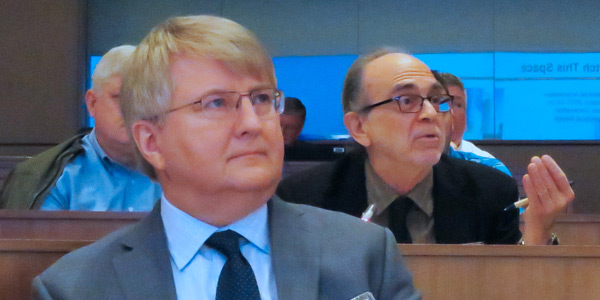By Rich Heidorn Jr.
CARY, N.C. — Stephen Rourke, vice president of system planning at ISO-NE, worries distributed energy resources will force RTOs to change their focus.
“We’re so used to operating at the wholesale level. We dispatched 350 generators for the last 40 years. Now there’s 108,000 solar installations. So we’re kind of getting dragged, whether we like to or not, from a wholesale view of the power system, to a retail view,” he said during the RTO Insider-SAS ISO Summit at SAS headquarters last week.
“What we won’t have [visibility of] is if everybody who has solar panels in their houses puts a 4-kW battery in their garage — and there are hundreds of thousands of those. So that’s going to be a data challenge.
“If you’re 5 MW or greater, you need a [remote terminal unit], you have to have a leased telephone line. Those are thousands of dollars to buy and hundreds of dollars a month to lease the phone line. Your 500-kW solar panel can’t afford to do that, but we have thousands of them. So how do we get the data and how do we process the data? It is … a challenge for us. So we’re going to need help from others certainly with the technology platform.”
‘Layered Control Structure’

Lorenzo Kristov, principal for market and infrastructure policy at CAISO, says it doesn’t have to be the RTO’s headache. He has proposed what he calls a “layered control structure” in which the distribution utilities would aggregate DER data for their RTOs.
“Each tier in this hierarchy only needs to see interchange with the next tier above and below, not the details of what’s going [on] inside because the optimization is happening locally,” he explained. “The ISO then focuses on bulk system integration, while the distribution utility … coordinates the operation of the DERs. The layered control structure reduces complexity, allows scalability and increases resilience and security. And finally the fractal structure mimics nature’s design of complex organisms and ecosystems.”
Kristov urged DER aggregators to bring “use cases” to CAISO to aid it in updating its market rules.
Currently, the ISO uses one of two models for DER: the demand response model and the non-generation resource used for storage. “When you’re charging, you’re using energy at retail; your ability to provide services to the ISO is very limited.
“Several parties have signed up as [DER] aggregators, but they haven’t brought in the resource yet,” he said. “Part of what we’re trying to figure out is what do we need to do to improve those rules. So I would say more active engagement in our stakeholder process [is needed] to bring us specific use cases. How do we want to operate in your markets? What is it we want to do? What are our capabilities? There’s a lot of technical detail that we can’t figure out because it’s the developers who have these things in mind.”
Standards Needed

DER also needs standards, said Ralph Masiello, senior vice president of Quanta Technology. He cited the aftermath of Superstorm Sandy in New Jersey in 2012.
“Too many of those [solar] installations did not disconnect when the distribution circuit went dead and so restoration was held up by the need for utility linemen to come verify that the line was dead before the tree crews could start clearing the debris,” he recounted.
“Normally the utility knows from its SCADA that the line is dead. But if you have just one … PV panel that didn’t de-energize, it’s enough to put high voltage on a downed line and make it dangerous. So there’s kind of a big data opportunity there. The utility needs to know where are those panels and what is their status.”
Solar PV could create a role on distribution systems for synchrophasors that previously have been used mainly in transmission, Masiello said, citing a Department of Energy project testing whether PV panels can be used to develop “synthetic inertia.”
“Can you take a smart inverter on PV — it’s already got communications and … time-synch capability — and build the synchrophasor into that smart inverter? And then you can use it as a key to developing local synthetic inertia from the panels.”
Masiello also said his company is beginning to get requests to do forecasting on the distribution systems.
One need, he said, is identifying distribution lines subject to solar “backfeeding” onto the transmission system, as has become common in Germany and begun happening between 10 a.m. and 2 p.m. in Hawaii.
“In other words, there’s not enough load on a segment of line to be able to absorb all of the solar that’s being generated,”
he explained. Utilities “may have to move some customers from one distribution segment to another.”




